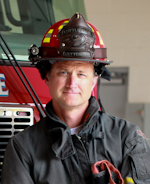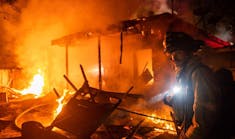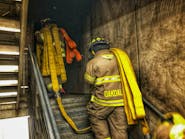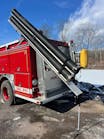Beyond Hoses & Hydrants
No matter where we stand on the modern fire-attack debate, on combination nozzle vs. smooth bore or on East Coast vs. West Coast tactics, one thing that we all can agree on is water puts out fires. One key component to getting water onto the fire is efficiently establishing a water supply. We need to look at water supply more than merely laying a hoseline from the hydrant to the fire.
It starts at the engine house
Establishing an effective water supply begins at the engine house, long before the incident. If your department has an established water-supply policy, the company officer must ensure that members are familiar with the expectations. In the absence of an established expectation, a company must define its expectation. In the case of an organization that has riding assignments, the riding assignments should include truck check responsibilities.
First, let’s size up the apparatus. Not all intakes are built the same. What intake will allow the most volume of water to enter the apparatus with the least amount of pressure loss? In most incidents, we can overcome small losses in gallonage and pressure. Take, for example, engine companies that have three large-diameter inlets: one on the driver’s side, one on the officer’s side and a front intake. The front intake is the tried-and-true method for supplying the pumpers. It’s easy, and it has a short pony section (5-inch line), which makes attachment to the hydrant easy. Some front intakes have six 90-degree bends.
However, the side intake is a more efficient way to introduce water to the pump, and it minimizes losses in gpm and pressure.
Are there features of the apparatus that the crew must be aware of before establishing a water supply? Some apparatus don’t have a gate valve on their large-diameter intake. The advantage to this set-up is water can be placed directly into the pump, which maximizes the available water. The disadvantage is that the water supply must be established before the pump is engaged. Similar set-ups can be found on aerial companies that have two large-diameter intakes for the water way. The water-way intakes might not be gated. Crews need to connect both lines before the start of the operation or completely shut down the operation if they want to introduce an additional water supply.
As firefighters, we must understand the limitation of our apparatus. For roving drivers that fill in on a variety of apparatus, this is further complicated. Also, when a reserve apparatus is assigned to your engine house, you must look at the apparatus with a critical eye. True, it’s difficult to invest a lot of time into a temporary apparatus, but the fact of the matter is, if there’s going to be an opportunity for something to go wrong, it’s more likely to be on an older reserve apparatus that a crew isn’t used to working with.
Aging and delamination
When we handle the hose, we must truly look at it. Are there any indications that the hose is delaminating? This risk increases with hose that’s been in use for more than 10 years. Delaminating is when the interior lining of the hose becomes disconnected from the exterior jacket.
A number of years ago, my organization realized we had a delamination with our supply lines. We began to have decreased flows, and the hose wasn’t laying down right. Further research indicated that several hose manufacturers were experiencing delamination problems with large-diameter hoses. The liner was occluding the pipeline, which choked our 5-inch supply line down to the equivalent of a 1- or 2-inch orifice.
Taking it to the streets
Crews should get in the habit of spotting hydrants every time that you disembark from the apparatus. Make it a game with the crew to see who can spot the hydrant first. You should do this on fire alarm soundings, medical calls and area familiarization. When you take this to an advance level, crews should look for obstacles, identify main sizes or estimate the stretch. When you spot hydrants as a part of your usual routine, it becomes unconscious competence, a mastery of the skill.
Crews must learn about the unique features of their water supply system. For example, are there areas that have low flow? Are there areas that have high pressure? For example, in the first-due area where I work, there are two different water companies. The hydrants of one of the systems are painted silver and blue, so there isn’t an NFPA color reference on the hydrant. Some streets in the response area have both hydrants on the same street. This gives us the advantage of two independent water supplies.
Also, are there limitations to the amount of water that’s available? System demands might reduce the amount of water that’s available for firefighting efforts—for example, industrial companies’ water demands during their operating hours. Another example—and more applicable to most of us—is the daily demands of residential customers during peak times, such as the morning or evening, as customers take showers, wash dishes, etc.
An additional limitation of a water system might be the amount of water that’s available. For a municipal system that’s supplied by a water tower, firefighters must understand the daily demands on water in the tower and how much water might be available for firefighting efforts.
Command staff should inquire how long it typically takes to fill the water tower when it becomes low.On scene
Once on scene, the supply line should be laid close to the curb to keep a lane of travel open for incoming companies. Otherwise, in the event of later-arriving companies, the line must be moved to the side, so it isn’t run over regardless of whether it’s charged. Consideration should be given to the fact that when the line is charged, it will expand in the street and lengthen. Crews should attempt to pull the line straight and remove as much slack as possible before charging it.
Hoselines shouldn’t be in the incident run-off, if possible, to minimize hose contamination. In the event of an occupied garage fire, automobile gasoline tanks have been known to fail, which can create a running gasoline fire. We must protect our supply line from traffic, run-off, heat from the fire and heat from apparatus exhaust.
Once the line is charged, it’s difficult, at best, to move the line. A 5-inch hose weighs about 1.25 lb. per foot. In the case of a typical line (100 feet), a line weighs 125 pounds. The rule of thumb with 5-inch, large-diameter hose is 1 gallon of water per 1 foot of line. (We can quickly exhaust a booster tank by simply filling a large-diameter line.) Once the line is charged, another 833 lbs. of water is added. A charged 5-inch hose basically weighs 958 lbs. per 100-foot section—or about a half-ton per section.
Just as we chase the kinks in handlines, we must chase the kinks in supply line. Kinks reduce efficiencies. At times, when firefighters take the kinks out of a supply line, the line will roll or twist. In one incident, a firefighter’s finger became entangled in a twisting line, which created a spiral degloving of the firefighter’s finger. (Firefighters should wear gloves when handling hoselines.)
An incident commander (IC) should consider assigning a pumper to the hydrant to pump the supply line from the hydrant to the incident. This typically yields greater hydrant flow. A pumper at the hydrant with a full booster tank also serves as a tactical reserve in the event of a primary pump failure or a loss of the municipal water supply.
The booster backup establishes a supply line between the primary pumping apparatus and a later-arriving company. This backup, which has been made popular by Curt Isakson as he travels and teaches, essentially doubles the size of the available water before establishing a sustained water supply. In the event that a water supply is established, the booster backup serves as a tactical reserve of water. Take the case of an organization that has 750-gallon booster tanks. A booster backup creates a 1,500-gallon tactical reserve in case anything goes wrong. This system also creates a redundancy in the event of a primary pumper failure: The second pumper can pump water through the initial pumper.
It’s a little ironic during live fire training that we need to have a secondary water supply, when we burn in a controlled atmosphere within our burn building, but we don’t use a secondary pump for an uncontrolled fire in a building that isn’t designed for burning with unknown fire load.Don’t be limited
Often when we look at water supply and pumping, we see firefighters seemingly boxed in by the numbers: “Our pumper has a 2,000-gpm pump, so the most water that I can get out of the pump is 2,000 gpm.” False. Many drivers don’t know that pumps are rated from draft. You can pump much more gallons per minute from a pressurized source.
Hydrants are typically three outlets, yet we only see supply lines attached to one outlet. Depending on the water-main size, it’s possible to get more water out of a hydrant beyond a single outlet. Firefighters must attach a gate valve to at least one additional outlet to allow for expansion of supply lines, particularly along the larger mains that are typically found in commercial and industrial areas that have higher flow requirements.
Likewise, you must look at your apparatus unconventionally. In the absence of a Siamese, you can use adaptors to use a gated wye backward. This can be used to pump two 2½- or 3-inch lines to supply a large-diameter hose.
When maximizing the pump capacity of your apparatus and you run out of discharges, don’t forget the deck gun outlet. Yes, attach a 3-inch line to the deck gun. If you take a critical look at your apparatus, your deck gun is one of the largest, most direct outlets from your pump.
Firefighter safety
Firefighter training must include challenges and obstacles to making a hydrant. Firefighters must be trained on how to overcome obstacles, such as missing cap nuts, and on when it’s time to abandon one hydrant and to begin to look for another. Firefighters must be trained to notify command when water supply issues can’t be overcome quickly.
Firefighters must train and be prepared to quickly replace a damaged or broken supply line. Is the plan to shut down the hydrant or use a hose clamp? Firefighters need two lines to replace a single broken section to make up for the hose expansion when the line was charged. The IC must take into account the safety of interior crews who lack an established water supply.
Firefighters also must be cognizant of the hydrant stem as they open it. In one close call, a firefighter who was performing hydrant testing went to close the hydrant, and the retainer cap began to loosen. The stem retainer cap came off under pressure, and it struck the firefighter in the head, rendering him unconscious.
Water supply and efficiency
When we train and drill on the subtle details of making our operations more efficient, we improve the safety margins for our firefighters and the citizens who we protect. In the modern-day fireground, the homes are bigger and have a larger fire load. One way that we can gain on our competition, the fire, is crew efficiencies. As we increase our knowledge, perform manual training and build subtle efficiencies into our crews, we become faster. In today’s modern fires, seconds count. Crews must have the safety of an established water supply in every working fire incident.

Brian Gettemeier
Brian S. Gettemeier has been in the fire service for 31 years, the past 28 years as a career firefighter with the Cottleville Fire Protection District of St. Charles County, MO, where he serves as an engine company captain. He is a member of St. Louis Metro Urban Search and Rescue Task Force 1. Gettemeier is a second-generation firefighter. He has a bachelor’s degree in fire service management from Southern Illinois University and holds numerous state certifications. Gettemeier teaches all-hazard classes for numerous municipal and industrial organizations throughout the states of Missouri and Illinois. He presented at Firehouse Expo multiple times.








